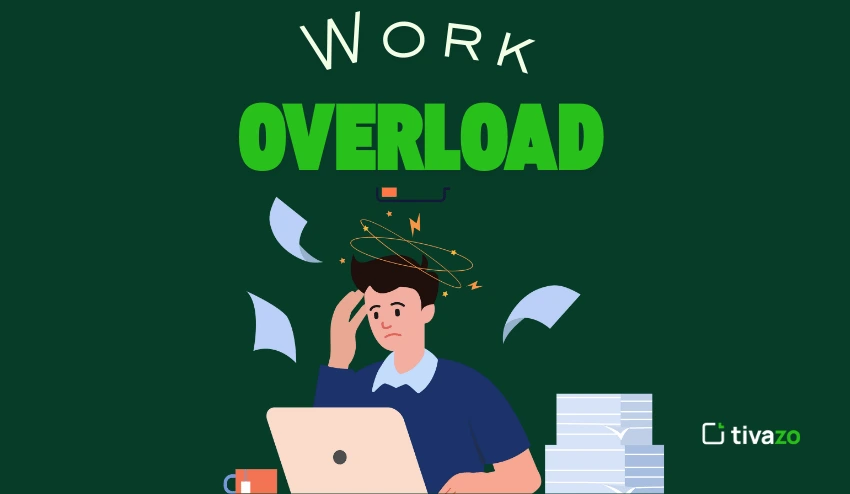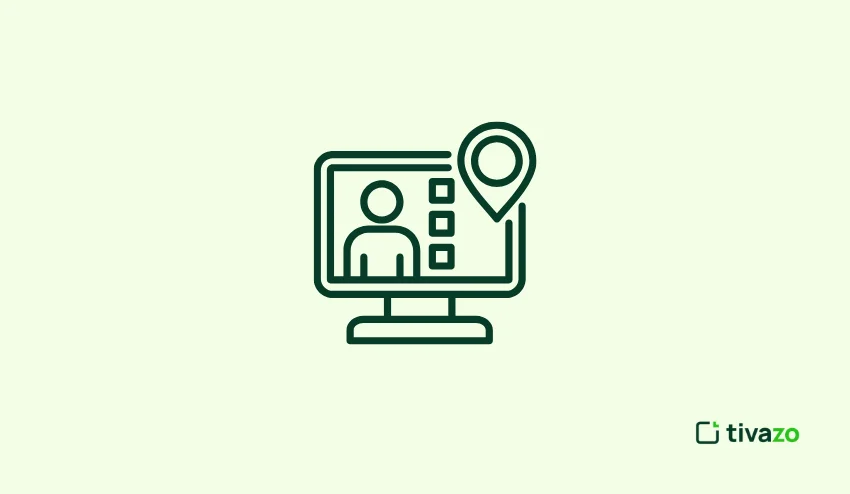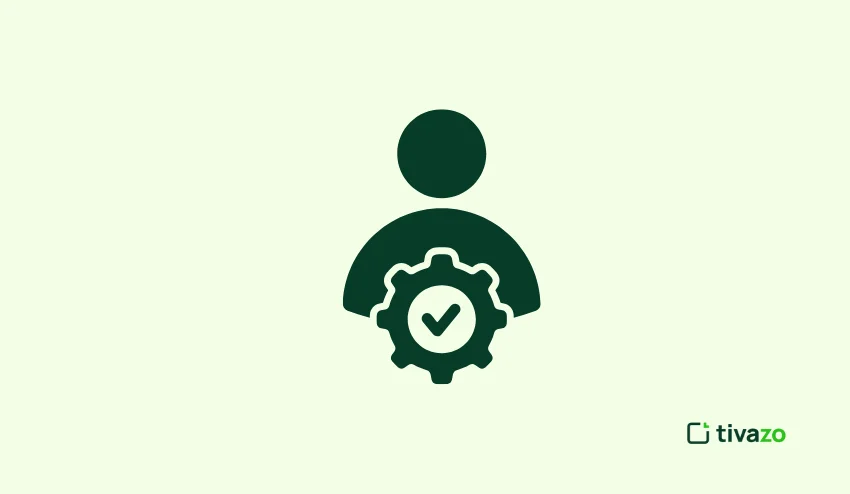Work overload is an increasing issue in today’s quick-paced workplace. A worker’s productivity, morale, and mental health may be compromised when an individual is overwhelmed with too many tasks. This guide has everything you need to know about work overload, its symptoms, effective coping strategies, implementation in teams, and recovery. Work overload can affect an individual outside of the work environment and impact their personal life, causing stress, fatigue, and relationship issues. There are many reasons for work overload, as well as early warning signs that should be recognized by employees and managers alike. Workload management can provide employees and managers with the tools to support a healthier and more productive workforce, mitigating burnout and enhancing organizational performance.
What exactly is Work Overload?
Work overload occurs when a person or team is unable to do the tasks required of them in a reasonable amount of time. Work overload can be temporary (e.g., peaks in projects) or chronic (e.g., poor workload management). If a person experiences work overload over an extended period, it can lead to stress, burnout, and decreased productivity. In this scenario, the impact of work overload will go beyond the individual’s performance and potentially influence the performance of other team members, client satisfaction, and the organization.
Primary causes of work overload include:
- Poor task delegation
- Unrealistic deadlines
- Poor prioritization
- Too many tasks at once
- Too few resources
To add to this list, work overload can arise from unclear role definitions, too many interruptions, or continued changes in priority assignments. Employees who do not have the tools, training, and support to manage tasks are more vulnerable to experiencing work overload. Recognizing the causes of work overload is the first step in preventing it from happening and achieving a balanced and effective work environment.
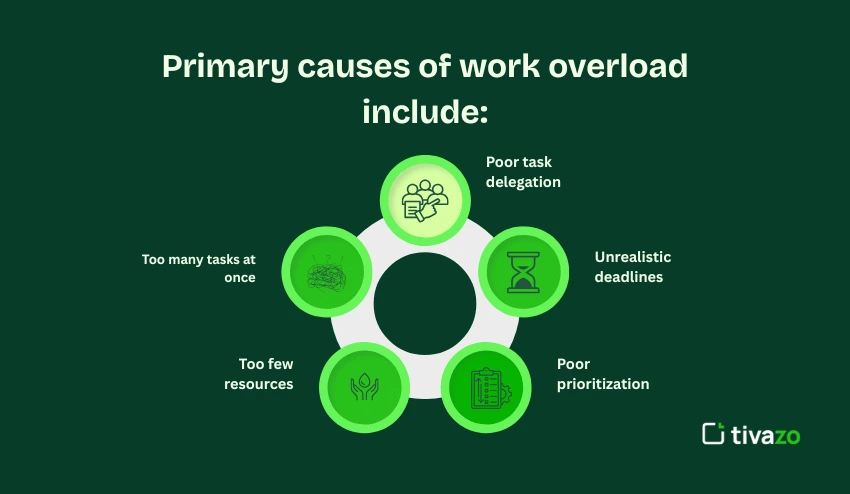
Indications of Work Overload
It is helpful to recognize work overload as early as possible. Common indications of work overload are:
| Indication | Explanation |
| Fatigue | Feeling tired on an ongoing basis, even when you have rested |
| Stress | Having heightened anxiety and frustration |
| Reduced effectiveness | Taking longer than normal to do work |
| Increased mistakes & errors | The quality of work is failing |
| Health issues | Stress-related symptoms like headaches, poor sleep, etc. |
| Social withdrawal | Avoiding your colleagues because you are overwhelmed |
Other less obvious indications could be irritability, lack of motivation, inability to focus, and forgetfulness. Employees experiencing work overload may also demonstrate prolonged emotional exhaustion, which can manifest as fluctuating moods or no longer being excited about things they used to be excited about. The benefits of recognizing overload early are that it helps them as an individual, or you as a manager, take action to strive for recovery from work overload, and avoid burnout while preserving a healthier and productive work situation.
How to Deal With Work Overload
Overcoming work overload requires both individual practices and organizational techniques:
1. Prioritize Tasks
To prioritize tasks, use methods like the Eisenhower Matrix or ABC prioritization to help identify important tasks. Focus on what is most important. Continuously re-evaluate which priorities are urgent or impactful, and focus on them first.
2. Set Realistic Deadlines
Avoid committing to timelines that are not possible. Break large projects into smaller, achievable milestones. Build in some buffer time to prepare for unforeseen delays.
3. Delegate Effectively
Distribute tasks based on the talents of your team members. Delegate so as not to burn out your team and help foster collaboration. Allowing others to be included and to take ownership fosters more teamwork.
4. Minimize Multitasking
Work on only 1 item at a time. Multitasking can make work take much longer and lead to higher errors. Experiment with time-blocking techniques to stay in the zone.
5. Learn to Say No
Say no when you’re not able to take on more. Say no professionally. When you talk to your manager or your colleagues about your capacity, be sure to communicate your limits directly. Saying no will add to your productivity, and first and foremost, your well-being.
6. Use Productivity Tools
Use productivity tools, like Asana, Trello, or Monday.com, to provide an efficient means of tracking workload, deadlines, and responsibilities. Use reminder and checklist functions, and use progress because you can track status and workflow.
7. Take Breaks
Taking breaks can improve focus, help with mental clarity, and reduce your overall stress. You can also combine a break with stretching, or some brief walking, or practicing mindfulness to help reboot your energy and refocus your mind.
8. Ask for Help
Be proactive about discussing workload concerns with managers or colleagues. Frequently reaching out to share the responsibilities or gaining clarity can help you avoid overwhelming situations before they even arise.
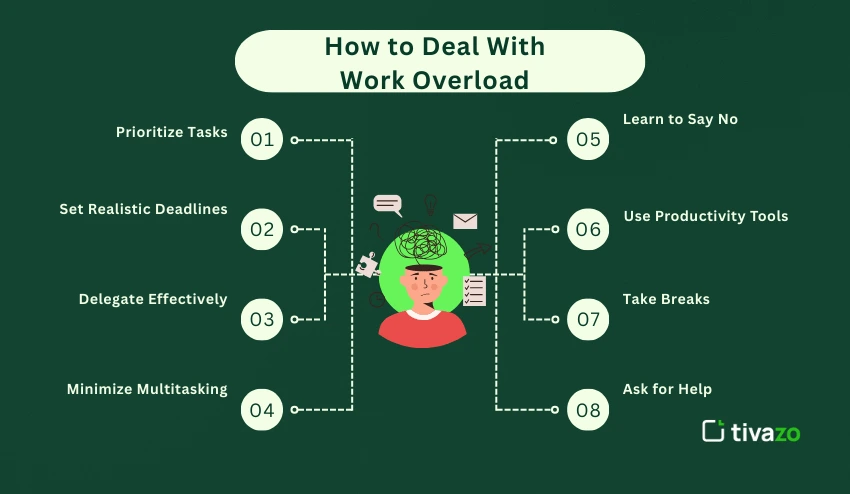
How to Manage a Team That is Overworked
Managing team work overload includes proactive planning and ongoing support:
- Monitor Workload: Regularly monitor each team member’s capacity. Monitor what tasks are being done and when they are due using dashboards, spreadsheets, or project management software.
- Support & Foster Open Communications: It is important to help your employees feel safe to express a concern about their workload. This is necessary so that your employees cannot feel like they are going to be judged in any way for expressing how overwhelmed they feel.
- Balance Workloads: As you assign work, you need to consider the existing skill level, experience, and workload of the employee. Do not pile more work on a high-performing employee, and do not allow a lesser-performing employee to evade their share.
- Provide Resources: In some instances, it will be helpful to provide extra tools, training, or even hire a short-term resource. You are trying to help your team do their job with as little pressure as possible.
- Recognize the Hard Work: Recognition can be a huge boost to team morale and employee engagement. Recognize hard work as soon as you can, have a party celebrating successes, and encourage peer recognition so that it’s a part of the work culture.
Finally, make a habit of checking in regularly with team members to be on top of issues with workload overload and to help reset priorities. Create an environment of empathy, transparency, and teamwork so that when team members experience overload and burnout, they are doing so in an environment that enables employee performance and satisfaction.
4 Recommendations to Help Your Team Sidestep Work Overload
1. Plan Ahead
Think about the times when you might have a lot of work and planning. Consider when you expect peak workloads and plan for your staffing accordingly so that your employees have the time and space to finish their work.
2. Set Clear Expectations
Be clear at the start as to the expectations of priorities, timelines/deadlines, and responsibilities. Clear expectations allow your employees to focus on their most impactful work and reduce confusion and duplicate work.
3. Create a Work-Life Balance
Promote breaks, holidays, and realistic hours. Depending on your workplace, accommodate flexible working schedules when possible. Call out situations when people work late or overtime to promote the well-being and health of your employees.
4. Regular Check-Ins
Have weekly team meetings to identify and respond to work overload risks. Moreover, these once-a-week meetings can be an opportunity to get feedback, redistribute work, and acknowledge success. When you address work concerns before overload occurs, you can ward off burnout earlier and keep everyone motivated.
Furthermore, by creating an environment modelled around collaborating, where staff can ask for help and share responsibility, you can create resilience and employee productivity in the long term.
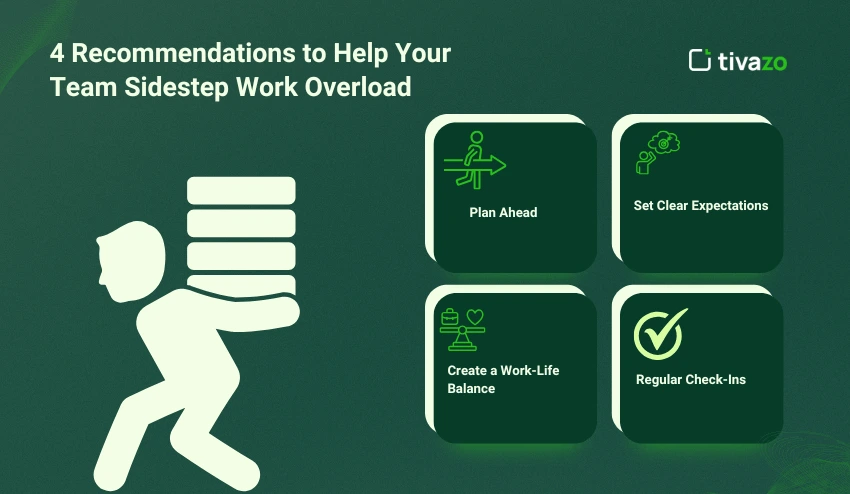
How to Manage Work Overload
Short-Term Solutions:
- Cut down on unnecessary meetings that waste valuable time.
- Delegate tasks to team members who have the ability and expertise to handle the job effectively.
- Revised priorities by focusing on high-value-added tasks and deferring lower-value-added work.
- Open up about challenges and issues with managers and colleagues to prevent the backlog from building.
Long-Term Planning:
- Implement workload management models to forecast and allocate workload.
- Investing in automated programs for the removal of repetitive tasks
- Encourage realistic deadlines and promote taking regular breaks for well-being
- Acknowledge and reward employee contributions to improve morale.
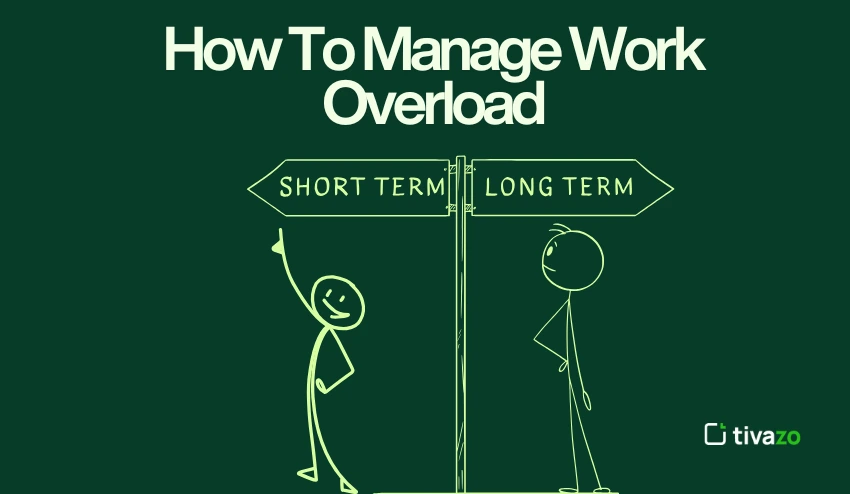
Ideas for Communicating: You Can’t Manage Your Workload
It is always important to effectively communicate overload from a well-being, productivity, and team perspective. Being proactive in this way can help prevent burnout and incentivize better task management. Here are a few tips:
- Clearly Define Which Tasks Are of Concern: Identify specifically what projects, assignments, or specific tasks are making you feel overwhelmed. Identify when they are due, the volume of tasks, where possible, and highlight any slowdowns or blocks that prevent you from making the intended progress.
- Provide Scheduling Examples/Enforcement to Illustrate Your Workload: Provide specific examples of what is making your workload heavy, such as the number of hours you will need to complete each task or the responsibility for two overlapping roles, etc.
- Provide Some Alternatives, Solutions, or Redistributing Workload: Provide concrete suggestions like delegating, extending deadlines, or priorities.
- Keep it Professional and Constructive: An important thing about communicating workload challenges is focusing on a solution-oriented approach instead of complaining, being constructive, and working together respectfully.
- Schedule a Meeting: Request to have a meeting as a one-on-one. Do not use passing conversation or publicly communicate your workload.
- Follow Through: After the conversation, follow through on the expectations, completion, and update your boss in the meantime, so they see your action and accountability.
How you communicate makes an important difference in how your messages are received when working to maintain professional relationships while meeting and sustaining team productivity.
Strategies for Recovering From Overwork
Recovery from being overworked involves re-energizing yourself on a physical, mental, and emotional level:
- Rest & Sleep: Get 7 to 8 hours of quality sleep each night.
- Exercise & Nutrition: Continue to exercise and eat well.
- Digital Detox: Minimize notifications and after-hours work.
- Seek Help: Speak to a mentor, human resources, or a mental health professional.
Conclusion
One of the most common but unrecognized workplace challenges today is work overload. Employees can only work so much. When the “to-do” pile grows to unreasonable levels, it will impact their productivity, well-being, and morale. Long-term impact will reach organizations’ effectiveness and success. The first step in solving your work overload dilemma begins by recognizing the symptoms of work overload, which may include fatigue, stress, reduced productivity, and declining performance. After identifying the symptoms, it is up to the individual and the team or leader to mitigate the impact and reduce overload for a healthier balance.
On the individual level, prioritizing work tasks, working to set deadlines for all tasks, learning to say “no,” and taking breaks are workplace strategies for employees to manage their work better. On the team level, those in leadership positions need to monitor workload, delegate, create boundaries for tasks, and allocate resources to mitigate and manage potential burnout. On the organizational level, consider long-term sustainable solutions, including work automation, better planning, and a culture of work-life balance.
At the end of the day, solving work overload is about more than just (time) management. It is about creating a workplace culture where individuals are able to succeed, collaborate, elevate their work, and be at their best without sacrificing their physical and mental well-being. The first step in a healthier work culture starts with open communication, recognizing teammates for their hard work and contribution, and smarter workload management practices, allowing for employees and organizations to shift their overload into an opportunity to succeed.
